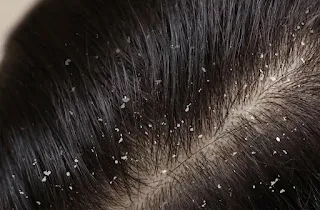Dandruff
Introduction
Dandruff (pityriasis capitis) is a chronic, relapsing, noninflammatory hyperproliferative skin condition, which is often seen as socially unsightly and a source of embarrassment.
- The condition usually appear during puberty and reaches a peak in early adulthood.
- It is considered to be a mild form of seborrheic dermatitis, associated with an overgrowth of the yeast Malassezia furfur.
Symptoms
Dandruff is characterized by greyish-white flakes or scales on the scalp and an itchy scalp as a result of excessive scaling. It may also affect beards.
- Flakes of dead skin are usually visible in the hair close to the scalp and are visible on the shoulders and collars of clothing.
Management
The use of a hypoallergenic shampoo on a daily basis will usually control mild symptoms.
In more persistent and severe cases, a medicated shampoo can be used to control the symptoms. Treatment options include
- Coal tar
- Unknown mechanism of action.
- Can cause skin sensitisation and is a photosensitiser.
- Zinc pyrithione
- Should be used daily until dandruff clears.
- Selenium sulphide
- For adults and children >5 years old, use the product (left on for 5-10 minutes before rinsing) twice a week for the first 2 weeks and then once a week for the next 2 weeks.
- Gold, silver and other metallic jewellery should be removed before use because they can be discoloured.
- Ketoconazole
- Should be considered for more persistent or severe dandruff.
Most treatments need to be left on the scalp (and beard where relevant) for 5 minutes before rinsing for full effect (see instructions with individual products).
NOTE: The results from studies on seborrheic dermatitis suggest that ketoconazole is the most effective and coal tar is the least effective of these choices.
Summary
As dandruff treatment rarely provides a permanent cure, long-term, intermittent treatment is essential for preventing recurrence.
External Links
- A randomized, controlled clinical trial of four anti-dandruff shampoos, 1981
- Effect of ketoconazole 1% and 2% shampoos on severe dandruff and seborrhoeic dermatitis: clinical, squamometric and mycological assessments, 2001
- A multicenter randomized trial of ketoconazole 2% and zinc pyrithione 1% shampoos in severe dandruff and seborrheic dermatitis, 2002
- Seborrhoeic dermatitis, 2007
- Seborrheic Dermatitis and Dandruff: A Comprehensive Review, 2015
- Topical antifungals for seborrhoeic dermatitis, 2015


Comments
Post a Comment